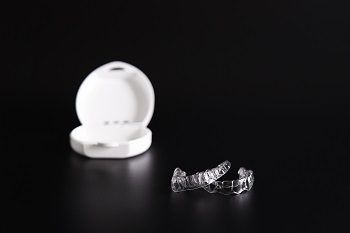Clear Aligners Vs. Braces
Dr. Hoss Abar
If you're looking to straighten or realign your teeth, there are a few choices to choose from, clear aligners and braces. People may not recognize that although they both have the same purpose, they both have distinct methods for achieving that goal. It is crucial to understand the distinctions between transparent aligners and braces; the most significant is the time required to straighten teeth.
Braces and clear aligners both have advantages and disadvantages, and it's important to know the difference. Clear aligners and braces seek to generate a straighter smile. However, clear aligners do it more quickly.
Clear Aligners Therapy (CAT):

Let's begin by explaining what CAT is. CAT employs a set of aligners made of translucent plastic worn for a specified amount of time to move teeth into their new positions gently. Aligners may be removed and are pleasant to wear. But how are the teeth aligned with this?
Because there are no wires or bands connecting transparent aligners, the patient completely controls their treatment. Your aligners will exert focused and controlled force on your teeth to move them into their proper places. Each set of aligners is precisely adjusted by the end of the treatment. To ensure that the teeth have successfully moved to their new positions.
Working:
Clear aligners function quite easily. To attain ideal results, the patient must constantly wear their aligners. It is only necessary to remove an aligner to regularly clean and floss one's teeth.
Many individuals may be unaware, yet clear aligners often operate considerably faster than braces. In contrast to braces, which exert pressure on each tooth, a clear aligner exerts a force on the whole arch of teeth. Clear aligners are considered more successful than braces if a patient adheres to their aligners regularly.
Braces:

The use of braces to straighten teeth dates back many years. Wires link brackets are attached to each tooth. The wire travels from bracket to bracket to align each tooth properly. The combination of bracket and wire exerts a modest amount of force on each tooth, generating the shift.
In comparison to aligners, braces require fewer adjustments by an orthodontist. Because braces operate to move each tooth independently, they require less care than clear aligners. On the other hand, braces need a higher level of care during everyday cleaning due to the wires and brackets on the teeth.
In a nutshell:
To understand the difference between clear aligners vs. braces, there is one substantial factor between how braces and aligners move teeth. Through brackets and wires, braces exert a pulling force to reposition teeth. However, aligners employ a gentle pushing force to guide the teeth. Even though aligners can shift teeth to their new locations in as little as 24 hours, professional advice is to be not hasty with this procedure as it exerts force to align the interior placement of teeth in the gums.
When correcting malocclusions, braces and clear aligners were both successful options. Segmented movement of teeth and shorter treatment time were advantages of clear aligners. However, they were less successful than braces.
If you’re ready to take the first step toward a beautiful smile, Contact your Pinole dentist, Dr. Hoss Abar, DDS, MSD at Abar Orthodontics.
Resource:
This media/content or any other on this website does not prescribe, recommend, or prevent any treatment or procedure. Therefore, we highly recommend that you get the advice of a qualified dentist or other medical practitioners regarding your specific dental condition
More To Explore
About Us
We believe that every patient deserves to feel confident about their smile. Years of experience creating beautiful and flawless smiles.
Opening Hours:
Monday - Thursday: 8:00 AM - 5:00 PM
Friday: 8:00 AM - 12:00 PM
Saturday - Sunday: Closed
Abar Orthodontics, Pinole, CA
1500 Tara Hills Drive., Suite 204
Pinole, CA 94564
Abar Orthodontics, San Leandro, CA
145 East 14th street., #100
San Leandro, CA 94577
© 2025Abar Orthodontics | All rights reserved | Powered by:Vigorant, Inc.
